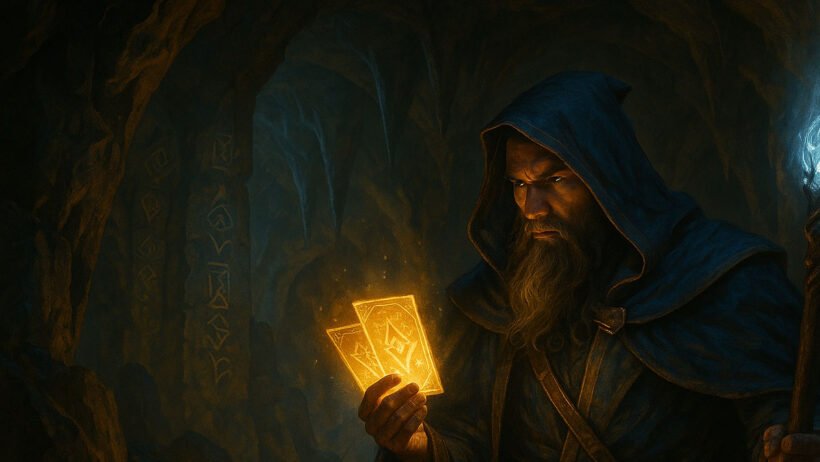What is the Discover Mechanic in MTG?
Magic: The Gathering is a game that never stands still. New mechanics constantly arrive to keep the gameplay feeling fresh, and one of the most impactful recent additions is the Discover mechanic, which debuted in The Lost Caverns of Ixalan.
This potent keyword action gives players a thrilling way to generate extra value and cast spells for free. It has already shaken up deck-building and in-game strategies across many of Magic’s formats.
The Core Concept: How Discover Works
At its heart, Discover is a simple yet powerful idea. It always appears with a number, written as “Discover X.” That number is the key to unlocking a free spell hidden in your deck.
When a card tells you to Discover X, you start a mini-game of exploration, digging through your library for the perfect spell to turn the tide of the game.
A Step-by-Step Breakdown of the Discover Process
The process is straightforward. You begin exiling cards one by one from the top of your library. You keep going until you hit a nonland card that has a mana value of X or less.
Once you find that card, you face a critical decision: cast it right away without paying its mana cost, or add it to your hand for later. Any other cards you exiled along the way get shuffled and placed on the bottom of your library.
Discover vs. Cascade: Understanding the Key Differences
Long-time Magic players will instantly recognize the similarities between Discover and the classic Cascade mechanic. While they clearly share some DNA, their differences are what make Discover a truly modern and strategic design.
Getting a handle on these distinctions is crucial for mastering both mechanics and knowing which one fits your deck’s game plan better.
A Tale of Two Mechanics: From Trigger to Action
The most important technical difference is how they function within the game’s rules. Cascade is a “triggered ability.” It goes on the stack as a separate object when you cast a spell with Cascade, and it resolves before that original spell does.
Discover, on the other hand, is a “keyword action.” It doesn’t use the stack on its own; it’s just part of the spell or ability that creates it. This subtle timing difference can have massive implications, especially when interacting with counterspells or removal.
Strategic Flexibility: The Power of Choice
Ask any player what makes Discover special, and they’ll point to the power of choice. With Cascade, you have to cast the spell you find if it’s legal to do so. If you can’t, it’s lost to the bottom of your library.
Discover hands you the reins by providing the option to put the card into your hand. This is a huge strategic upgrade. It lets you save a powerful spell for the perfect moment or avoid a play that would be awkward or even harmful at the time.
Mastering the Discover Mechanic: Strategy and Application
It’s one thing to have Discover cards in your deck, but it’s another to truly harness their power. That requires building your deck with the mechanic in mind, carefully shaping your mana curve and spell selection.
A well-tuned Discover deck doesn’t just get a random free spell; it creates a predictable engine that can overwhelm opponents with value.
Building Your Deck Around Discover
When you’re building a deck to maximize Discover, you want to skew your mana curve to hit your best possible spells. If your key card has Discover 4, you might want to minimize the number of 1 and 2-mana spells in your deck.
This kind of careful deck-tuning transforms the inherent randomness of the mechanic into a consistent and powerful advantage, making your plays far more explosive.
Notable Cards with Discover
It didn’t take long for Discover cards to make their mark. Geological Appraiser, a modest creature with Discover 3, proved so efficient in combo decks that it was eventually banned in the Pioneer and Explorer formats.
On the higher end, threats like Chimil, the Inner Sun and Quintorius Kand offer repeatable Discover effects. These cards can take over a game completely if left unchecked, becoming priority targets for any opponent.
The Impact of Discover on the MTG Metagame
The arrival of Discover was anything but quiet. The mechanic quickly established itself as one of the most formidable abilities printed in years, warping formats from kitchen table Commander all the way to the top tables of competitive tournaments.
Its unique blend of free-spell advantage and strategic choice has forced players to rethink how they build decks and interact with their opponents.
A Game-Changing Addition
Many in the community have hailed Discover as a more refined and balanced take on Cascade. The design cleverly sidesteps some of the issues that made Cascade a notoriously difficult mechanic to balance, while keeping the exciting, lottery-like feeling that players find so appealing.
It has spawned entirely new deck archetypes and revitalized old ones, cementing its legacy as a truly game-changing mechanic.
The Future of Discover
Given its immediate popularity and successful design, it feels almost certain that we will see the Discover mechanic again. Wizards of the Coast loves to revisit well-designed and beloved mechanics, and Discover fits that bill perfectly.
As Magic: The Gathering continues to evolve, we can expect to see new and interesting implementations of Discover, promising an exciting future for this fan-favorite ability.








